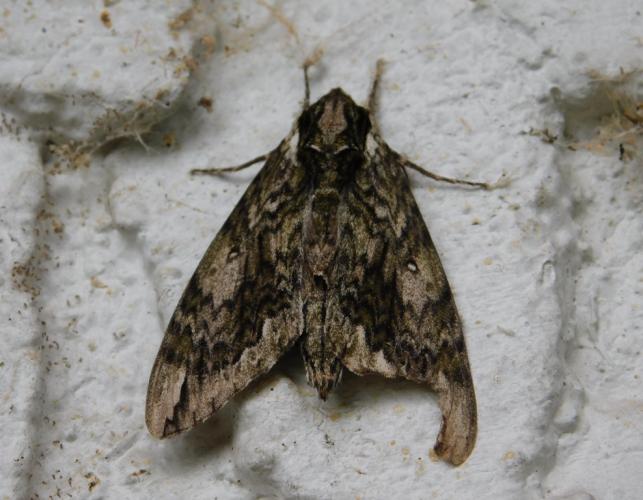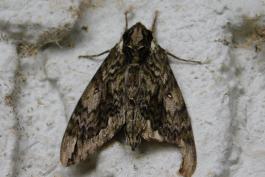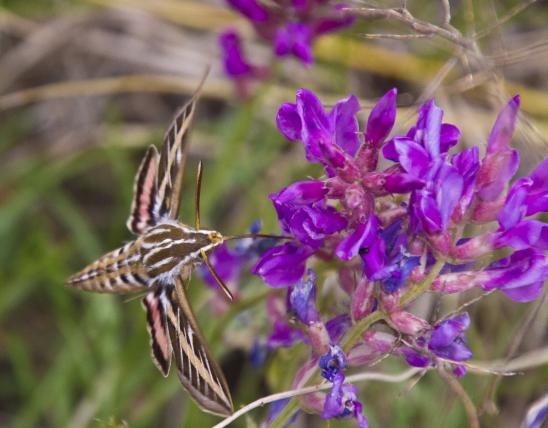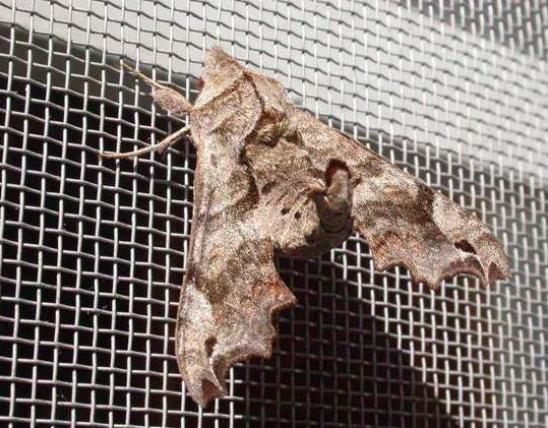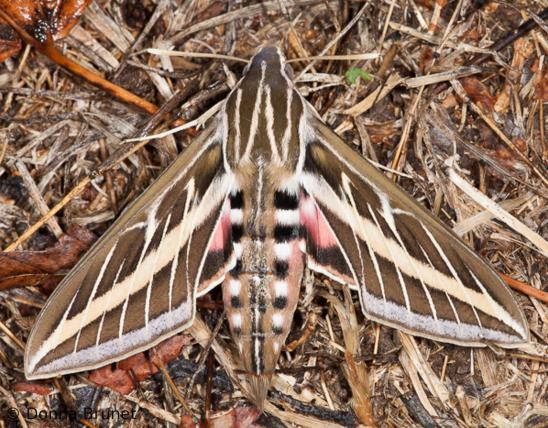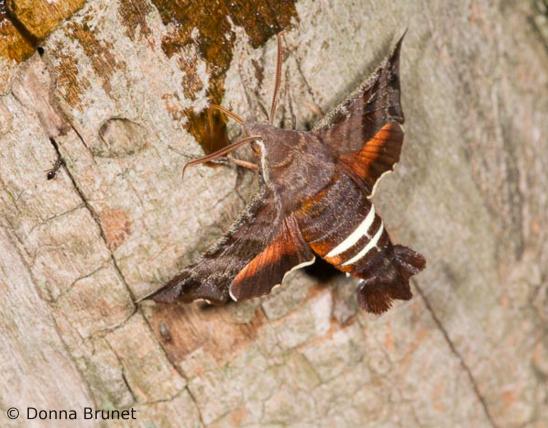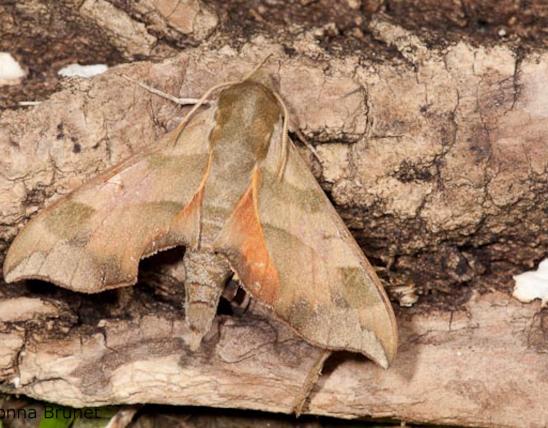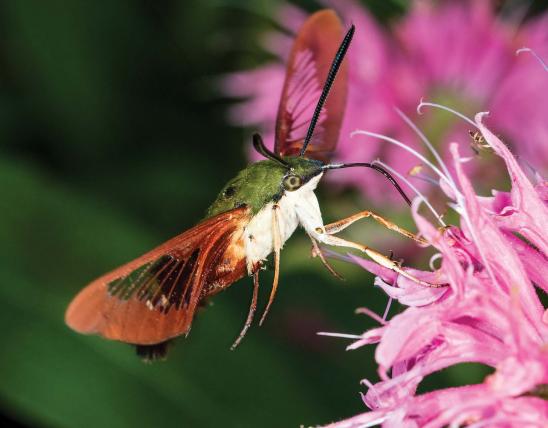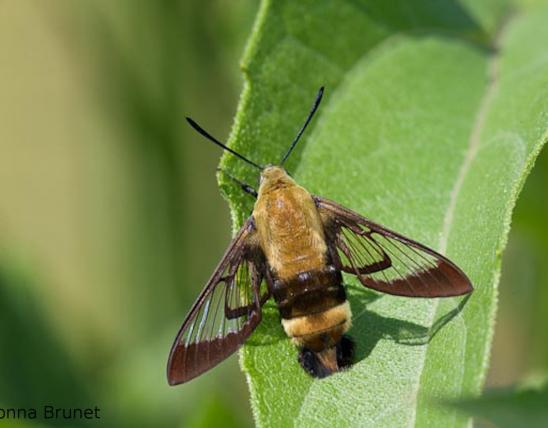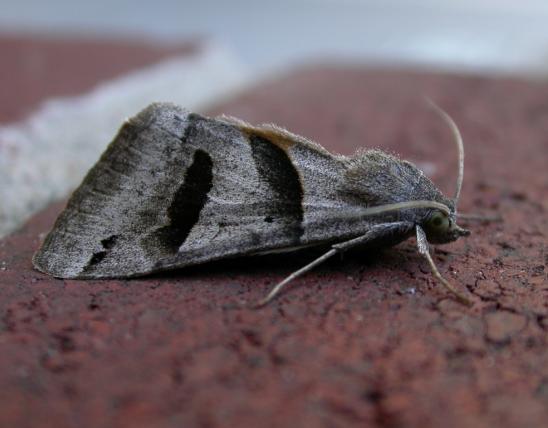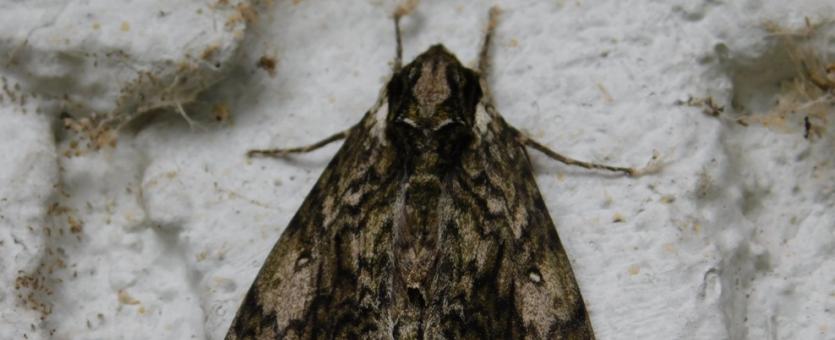
Hagen's sphinx is also called Osage orange sphinx for its larval food plant. Fresh adults will have a beautiful olive-green cast, while older individuals lack the greenish color and look simply grayish or brownish.
For exact identifications, look carefully at the wing color patterns. The forewing is decorated with dark zigzag lines, and there is one pale gray patch at the outer tip and another midway along the leading edge (costa); also, there is an elongated dark patch at the center of the wing. Unlike the similar elm sphinx (see below), there is no distinctly pale or whitish patch at the base of the forewing along the leading edge. The hindwing is dominated by a large dark brown or blackish patch, with only the base and a wedge-shaped portion near the trailing edge (near the body) lighter tan; the hindwing is not banded.
The caterpillars are pale green with short, pale oblique (slanted) bands and a green head. The tail-like horn is well developed; like others in the sphinx moth family, the caterpillars are often called hornworms.
Learn more about sphinx moths as a family on their group page.
Similar species: There are several species of sphinx moths that have tan or gray wings with wavy markings, including various hawk moths and hornworms (Agrius and Manduca species). Those, however, are larger and have clearly banded hindwings, often with pink or yellow on the black-banded abdomen.
Hagen's sphinx is most easily confused with the very closely related and similar-looking elm sphinx or four-horned elm sphinx (Ceratomia amyntor) and waved sphinx (C. undulosa). Close comparisons of the wing patterns separate them. Both of these lookalikes have banded hindwings; both rarely (if ever) have a greenish tinge; and the forewings of both do not match the description for Hagen's sphinx. The larval host plants are different, too: the elm sphinx eats the foliage of elms, and the waved sphinx mostly eats the foliage of ash (Fraxinus) and privet (Ligustrum). Of the two, the waved sphinx is more common in Missouri than the elm sphinx.
Wingspan: 2¾–3½ inches.
Statewide. Most common in localities where Osage orange trees (their larval food plant) are present.
Habitat and Conservation
This is a common moth in Missouri. This species occurs in regions and localities where Osage orange trees grow. Adults fly mostly at dusk and are attracted to lights. You might see them resting on the side of a building during the day, or hovering around flowers, drinking nectar, at dusk.
Food
The caterpillars eat the foliage of Osage orange trees (Maclura pomifera). The adults sustain themselves by drinking nectar from a wide variety of flowers at dusk.
Status
Breeding resident species with two or possibly three broods between May and October.
Life Cycle
These moths have two or possibly three broods per year in Missouri. People usually start seeing the adults in May. Mated females deposit eggs onto the food plant (Osage orange leaves), and the caterpillars eat, grow, and eventually pupate, emerging as winged adults.
Human Connections
This moth was named in honor of Hermann August Hagen (1817–1893), who founded Harvard University's department of entomology. A native of Prussia (Germany), he was also a medical doctor. In 1867, he immigrated to the United States and started working at Harvard. When he was given the title Professor of Entomology in 1870, he became the first-ever professor of entomology at an American university. As an insect scientist, he was especially interested in dragonflies, termites, and a broad group including lacewings, antlions, fishflies, and other membranous-winged insects; he did pioneering studies of extinct species preserved in amber. He also compiled a bibliography listing all the entomological publications up to 1862 and curated and organized Harvard's insect collections. The butterfly and moth specialist Augustus Radcliffe Grote named this species after him in 1874, just a few years after Hagan had accepted his professorship.
Ecosystem Connections
Hagen's sphinx moths provide food for a variety of insect-eating animals. They basically convert the leaves of Osage orange trees into a form that insect-eaters can consume and digest.
For many predators, such as birds and bats, sphinx moths are a nice chunky meal, and the various camouflage patterns on the forewings remind us that avoiding detection is a first line of defense.
Sphinxes and other moths that pupate in soil are a prize for insect-eating mammals such as shrews, moles, and skunks, plus snakes, lizards, frogs, toads, and salamanders.
Predation comes in different forms. In addition to animals that capture and eat sphinx moths, small parasitoid braconid wasps inject their eggs (usually about 150 at a time) into the bodies of sphingid caterpillars. Within the caterpillar’s body, the grublike larval wasps eat the caterpillar’s hemolymph (blood), but they do not damage tissue (this is why the caterpillar continues to live “normally”). When the wasp larvae have grown enough, they emerge out of the “skin” of the caterpillar, spin cocoons, and pupate. It’s very common to see curious silky white oval blobs attached to the skin of sphinx moth caterpillars — these are the cocoons of the pupating wasps. Once the wasps are pupating, the caterpillar stops eating. The wasp larvae ultimately kill the caterpillar.
As they hover around flowers drinking nectar, sphinx moths transport pollen from one flower to another, providing cross-pollination services for the plants that sustain them as adults.
